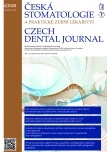DIRECT RECONSTRUCTION OF PERMANENT DENTITION OF A PATIENT WITH AMELOGENESIS IMPERFECTA
Authors:
T. Kovalský 1; B. Vágnerová 1; I. Voborná 1; R. Mounajjed 1,2
Authors‘ workplace:
Klinika zubního lékařství, Lékařská fakulta Univerzity Palackého a Fakultní nemocnice, Olomouc
1; Soukromá stomatologická klinika D. C. M., Hradec Králové
2
Published in:
Česká stomatologie / Praktické zubní lékařství, ročník 120, 2020, 4, s. 122-127
Category:
Case Report
Overview
Introduction and aim: Amelogenesis imperfecta associates a clinically and genetically heterogeneous group of developmental defects affecting the appearance and structure of enamel, which more or less severely affect all dental functions. Manifestations of amelogenesis imperfecta are considered by patients to be a compromise of aesthetics and increased tooth sensitivity. The consequences of the disease have a detrimental effect on adolescents who integrate into groups and seek their place in society. However, the traditional treatment approach can be very expensive and may require a certain degree of psychological resilience of the patient due to the pain and time consuming treatment. These treatment requirements, together with the insufficient thickness of the secondary dentin layer, thus often force the physician to delay treatment, which may adversely affect the patient's psychosocial development.
Self-observation: A fifteen-year-old patient was sent to the prosthetic department for complete reconstruction of permanent teeth with a diagnosis of hypoplastic amelogenesis imperfecta. Due to the nature of the disease, immediate direct reconstruction was performed.
Conclusion: An unprepared approach is possible even in adolescence. Hard dental tissues are preserved, the vitality of the dental pulp is not endangered and the patient's psychological burden is reduced. Direct reconstruction can be approached provided the patient cooperates. This approach must be combined with consistent treatment of the tooth surface to reduce adhesion and plaque retention. The advantage is also that any partial failure of the reconstruction is relatively easy to repair in the case of direct reconstruction.
Keywords:
amelogenesis imperfecta – direct reconstruction – aesthetic reconstruction – Birth defects
Sources
1. Witkop CJ, Sauk JJ. Heritable defects of enamel. In: Stewart R, Prescott G, editor. Oral facial genetics. St Louis: CV Mosby Company; 1976, 151–226.
2. Backman B, Holm AK. Amelogenesis imperfecta: prevalence and incidence in a northern Swedish county. Community Dent Oral Epidemiol. 1986; 14 : 43–47.
3. Adorno-Farias D, Ortega-Pinto A, Gajardo P, Salazar A, Morales-Bozo I, Werlinger F, Rojas-Flores S, Molina-Berríos A, Echeverría-López S, Jara-Sandoval J, Jara L, Urzúa B. Diversity of clinical, radiographic and genealogical findings in 41 families with amelogenesis imperfecta. J Appl Oral Sci. 2019; 27: e 20180359.
4. Ceyhan D, Kirzioglu Z, Emek T. A long-term clinical study on individuals with amelogenesis imperfecta. Niger J Clin Pract. 2019; 22 : 1157–1162.
5. Crawford PJ, Aldred M, Bloch-Zupan A. Amelogenesis imperfecta. Orphanet J Rare Dis. 2007; 2 : 17.
6. Weinmann JP, Svoboda JF, Woods RW. Hereditary disturbances of enamel formation and calcification. J Am Dent Assoc. 1945; 32 : 397–418.
7. Witkop CJ. Amelogenesis imperfecta, dentinogenesis imperfecta and dentin dysplasia revisited: problems in classification. J Oral Pathol. 1988; 17 : 547–553.
8. Aldred MJ, Crawford PJM, Savarirayan R. Amelogenesis imperfecta – a classification and catalogue for the 21st century. Oral Dis. 2003; 9 : 19–23.
9. Gadhia K, McDonald S, Arkutu N, Malik K. Amelogenesis imperfecta: an introduction. Br Dent J. 2012; 212(8): 377–379.
10. Ergun G, Kaya BM, Egilmez F, Cekic-Nagas I. Functional and esthetic rehabilitation of a patient with amelogenesis imperfecta. J Can Dent Assoc. 2013; 79: d38.
11. Kammoun R, Zmantar T, Labidi A, Abbes I, Mansour L, Ghoul-Mazgar S. Dental caries and hypoplastic amelogenesis imperfecta: Clinical, structural, biochemical and molecular approaches. Microb Pathog. 2019; 135 : 103615.
12. Coffield KD, Phillips C, Brady M, Roberts MW, Strauss RP, Wright JT. The psychosocial impact of developmental dental defects in people with hereditary amelogenesis imperfecta. J Am Dent Assoc. 2005; 136(5): 620-630.
Labels
Maxillofacial surgery Orthodontics Dental medicineArticle was published in
Czech Dental Journal

2020 Issue 4
Most read in this issue
- SCREW LOOSENING IN ABUTMENT: CAUSES, ORIGIN MECHANISM, COMPLICATIONS AND MANAGEMENT
- DIRECT RECONSTRUCTION OF PERMANENT DENTITION OF A PATIENT WITH AMELOGENESIS IMPERFECTA
- STAV ORÁLNÍHO ZDRAVÍ U PACIENTŮ S KARDIOVASKULÁRNÍM ONEMOCNĚNÍM - Původní práce – klinická studie
- SELECTED PROPERTIES OF CONTEMPORARY ENDODONTIC SEALERS: PART 1
